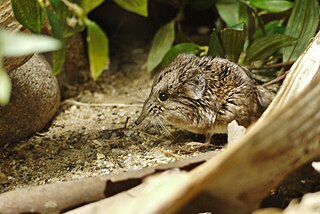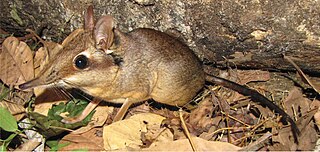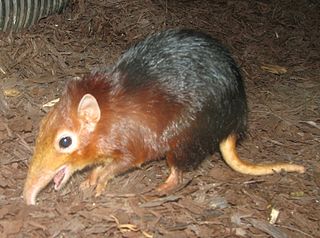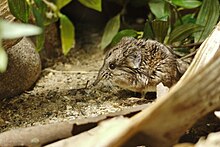
Elephant shrews, also called jumping shrews or sengis, are small insectivorous mammals native to Africa, belonging to the family Macroscelididae, in the order Macroscelidea. Their traditional common English name "elephant shrew" comes from a perceived resemblance between their long noses and the trunk of an elephant, and their superficial similarity with shrews in the order Eulipotyphla. However, phylogenetic analysis has revealed that elephant shrews are not properly classified with true shrews, but are in fact more closely related to elephants than to shrews. In 1997, the biologist Jonathan Kingdon proposed that they instead be called "sengis", a term derived from the Bantu languages of Africa, and in 1998, they were classified into the new clade Afrotheria.

A tenrec is a mammal belonging to any species within the afrotherian family Tenrecidae, which is endemic to Madagascar. Tenrecs are a very diverse group; as a result of convergent evolution, some resemble hedgehogs, shrews, opossums, rats, and mice. They occupy aquatic, arboreal, terrestrial, and fossorial environments. Some of these species, including the greater hedgehog tenrec, can be found in the Madagascar dry deciduous forests. However, the speciation rate in this group has been higher in humid forests.

The golden-rumped sengi is a small African mammal. It is the largest species of the elephant shrew family along with its close relative the grey-faced sengi. It is classified as endangered.

The black and rufous sengi, the black and rufous elephant shrew, or the Zanj elephant shrew is one of the 17 species of elephant shrew found only in Africa. It is native to the lowland montane and dense forests of Kenya and Tanzania. Like other members of the genus Rhynchocyon, it is a relatively large species, with adults averaging about 28 cm (11 in) in length and 450–700 g (16–25 oz) in weight.

The bushveld elephant shrew or bushveld sengi is a species of elephant shrew in the family Macroscelididae. It is found in Angola, Botswana, Namibia, and South Africa. Its natural habitats are subtropical or tropical dry shrubland and hot deserts.

The Somali elephant shrew or Somali sengi is a species of elephant shrew in the family Macroscelididae.

The North African elephant shrew or North African sengi is a species of elephant shrew in the family Macroscelididae. It is found in Algeria, Libya, Morocco, and Tunisia, and is the only extant afrotherian within its range. The species was formerly classified in the genus Elephantulus, but molecular evidence indicates that it is more closely related to Petrodromus than to other members of Elephantulus. It was moved to a new genus, Petrosaltator, in 2016. The split with Petrodromus likely occurred during the Miocene period.

The rufous elephant shrew, rufous sengi or East African long-eared elephant-shrew is a species of elephant shrew in the family Macroscelididae. Found in Ethiopia, Kenya, Somalia, South Sudan, Tanzania and Uganda, its natural habitats are dry savanna and subtropical or tropical dry shrubland.

The western rock elephant shrew or western rock sengi is a species of elephant shrew in the family Macroscelididae. It is found in Namibia, South Africa, and possibly Angola and Botswana. Its natural habitats are subtropical or tropical dry shrubland and rocky areas.

The round-eared elephant shrew or round-eared sengi, is a species of elephant shrew (sengi) in the family Macroscelididae. It is found in Botswana, Namibia, and South Africa. Its natural habitats are subtropical or tropical dry shrubland, and grassland, and hot deserts. They eat insects, shoots, and roots. Their gestation period is 56 days.

The four-toed elephant shrew or four-toed sengi is the only living species in the genus Petrodromus, which together with five other extant genera Rhynchocyon, Macroscelides, Petrosaltator, Galegeeska and Elephantulus constitutes the order Macroscelidea. This species is only found in particular regions in Africa and is smaller than its relatives. A comprehensive record of this species is lacking.

Rhynchocyon is a genus of elephant shrew in the family Macroscelididae. Members of this genus are known colloquially as giant sengis. They are a ground-dwelling mammal, significantly larger than their relatives in the order Macroscelidea that live primarily in dense forests across eastern Africa. Habitats range from eastern Africa's coastal forests, Rift Valley highlands, and the Congo basin. The species is widely threatened, with two of four assessed by the International Union for Conservation of Nature's Red List of Threatened Species. Habitat fragmentation from the growth of human settlements and activities are the primary threats to their populations. The genus contains the following five species and several subspecies:

Macroscelides micus is a species of elephant shrew in the family Macroscelididae. It is only found in gravel plains in the Etendeka formation of north-west Namibia. Measuring about 7.3 inches (19 cm) long and weighing less than an ounce, the species is the smallest in the elephant shrew family.

Macroscelides flavicaudatus is a species of elephant shrew in the family Macroscelididae found in the central Namib desert and southern Namibia.

Eorhynchocyon is an extinct mammal genus from the macroscelidid superfamily.
















